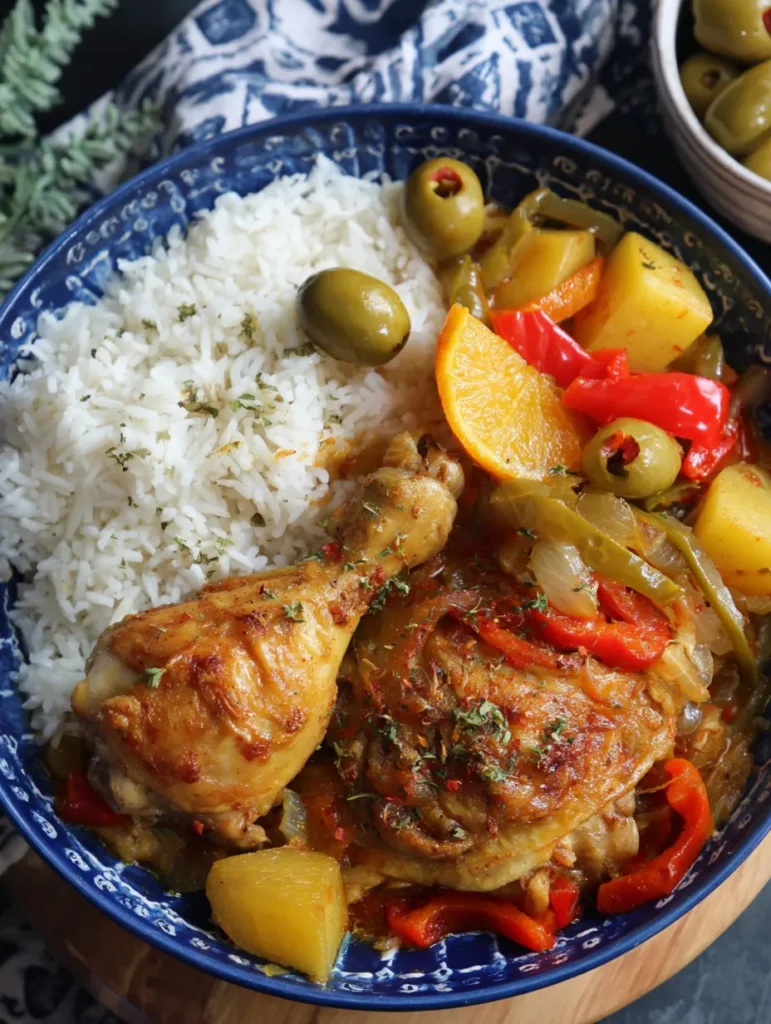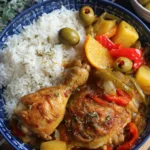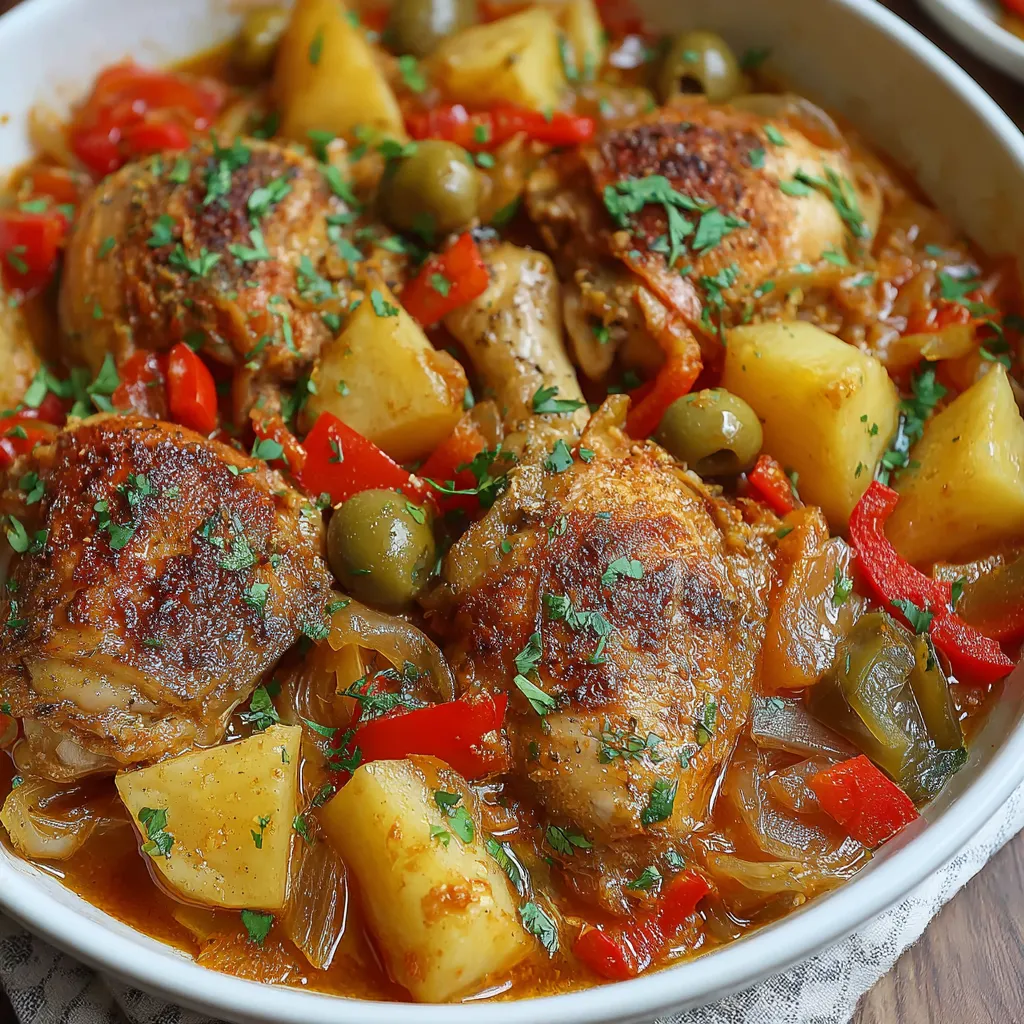Someone in Cuba figured out that if you brown chicken until it’s golden, sauté a ridiculous amount of peppers and onions, add wine and tomatoes, throw in some olives for brininess, and let everything simmer together until the chicken falls off the bone, you get something that makes people lean back in their chairs and go quiet for a minute. Cuban Chicken Fricassee (Fricase de Pollo) is what happens when Spanish sofrito meets Caribbean ingredients meets “I’m going to make this so good you’ll forget your own name” home cooking. It’s tender chicken swimming in a sauce that’s savory, slightly sweet, tangy from wine and tomatoes, and punctuated with briny olives and sweet peppers.
This isn’t some bland, beige chicken stew. This is “brown that chicken hard, caramelize those vegetables until they’re sweet and soft, deglaze with wine like you mean it, and simmer until the sauce is thick enough to coat everything in flavor” cooking. The chicken is fall-apart tender. The potatoes soak up all that incredible sauce. The peppers and olives add pops of flavor and color. Together, they’re the kind of one-pot meal that makes you understand why Cuban food has such a devoted following.
This is abuela energy without needing the abuela. It’s what happens when you take simple, accessible ingredients and treat them with patience and proper technique. It’s the kind of dinner that tastes like it took all day but actually just requires occasional stirring while you do other things.
Why This Cuban Fricassee Is About to Become Your New Comfort Food Obsessio
- Bold, complex flavor — Wine, olives, peppers, and spices create layers you can’t stop eating
- One-pot wonder — Everything cooks in the same pot. Maximum flavor, minimal cleanup
- Budget-friendly — Chicken thighs, potatoes, and pantry staples make this accessible
- Feeds a crowd — Easily serves 6-8 hungry people without breaking the bank
- Better the next day — The flavors meld overnight and somehow get even better
- Authentic Cuban flavor — Traditional recipe that tastes like someone’s kitchen in Havana
- Flexible and forgiving — Hard to mess up once you understand the technique
The Stuff You Need
For the Chicken:
- 3-4 pounds chicken thighs and drumsticks (bone-in, skin-on for maximum flavor)
- 1 teaspoon salt
- 1/2 teaspoon black pepper
- 1/2 teaspoon ground cumin
- 1/2 teaspoon dried oregano
- 3 tablespoons olive oil or vegetable oil (for browning)
For the Sofrito Base:
- 1 large onion, diced
- 1 green bell pepper, cut into strips
- 1 red bell pepper, cut into strips
- 4-5 cloves garlic, minced
- 1 teaspoon ground cumin
- 1 teaspoon dried oregano
- 1 bay leaf
- 1/2 teaspoon smoked paprika (optional but adds depth)
For the Sauce:
- 1 cup dry white wine (nothing fancy, just drinkable)
- 1 can (8 oz) tomato sauce
- 1/2 cup chicken stock or water
- 1 tablespoon tomato paste (concentrates the tomato flavor)
- 1 teaspoon sugar (balances the acidity)
- Salt and black pepper to taste
For the Mix-Ins:
- 4-5 medium Yukon Gold or russet potatoes, peeled and cut into large chunks
- 1 cup green olives with pimientos, drained (the Cuban signature ingredient)
- 1/2 cup raisins (optional but traditional—adds subtle sweetness)
- 2 tablespoons capers (optional but adds briny punch)
- 1/4 cup frozen peas (add in the last 5 minutes)
- Fresh parsley or cilantro for garnish
Optional But Highly Recommended:
- Red wine vinegar (a splash at the end brightens everything)
- Sazón seasoning packet (adds color and flavor)
- White rice for serving (non-negotiable in Cuban cuisine)
- Crusty bread for sopping up sauce
- Hot sauce at the table (for heat lovers)
- Extra olives because you can never have too many
Special Equipment:
- Large Dutch oven or heavy-bottomed pot with lid
- Tongs for flipping chicken
- Wooden spoon for stirring
- Sharp knife for chopping vegetables
- Patience (this dish rewards time)

Let’s Make This Fricassee That’ll Make You Feel Like You’re in Havana
Step 1: The Seasoning Setup
Pat the chicken pieces completely dry with paper towels—wet chicken won’t brown properly. In a small bowl, mix the salt, pepper, cumin, and oregano. Season the chicken generously on all sides with this spice mixture. Let it sit at room temperature for 15-20 minutes while you prep your vegetables. This brings the chicken to room temp for even cooking and lets the seasonings penetrate the meat.
Step 2: The Browning (Where Flavor Begins)
Heat the oil in your Dutch oven over medium-high heat until it’s shimmering and almost smoking. Working in batches if necessary (don’t crowd the pot), add the chicken pieces skin-side down. Let them sizzle undisturbed for 6-7 minutes until the skin is deeply golden brown and crispy and releases easily from the pot. Flip and brown the other side for another 5-6 minutes. You’re building a flavor foundation here—those brown bits stuck to the pot are pure gold. Remove the chicken to a plate. It’s fine if it’s not cooked through yet.
Step 3: The Sofrito Foundation
Pour off all but about 2-3 tablespoons of fat from the pot. If there’s not enough, add a bit more oil. Reduce heat to medium. Add the diced onion and pepper strips. Cook, stirring occasionally, for 8-10 minutes until the vegetables are very soft and starting to caramelize. They should be sweet and tender, not crunchy. This is the sofrito base—the flavor foundation of Cuban cooking. Don’t rush it.
Step 4: The Aromatics Attack
Add the minced garlic, cumin, oregano, smoked paprika, and bay leaf. Stir constantly for 1-2 minutes until incredibly fragrant and the garlic has softened but not browned. If you burn the garlic, it’ll taste bitter. Keep stirring. Your kitchen should smell absolutely incredible right now—that’s how you know you’re doing it right.
Step 5: The Deglaze (Critical Step)
Pour in the white wine. Use a wooden spoon to scrape up all those beautiful brown bits stuck to the bottom of the pot—this is called deglazing and it’s where massive flavor lives. Let the wine bubble and reduce for 3-4 minutes until it’s reduced by about half and the raw alcohol smell has cooked off. The liquid should look slightly syrupy.
Step 6: The Sauce Assembly
Add the tomato sauce, tomato paste, chicken stock, and sugar. Stir everything together until the tomato paste is fully dissolved and the sauce is smooth. Taste it—it should be savory, slightly acidic, and aromatic from the spices. Season with salt and pepper. Remember that the olives and capers you’ll add later are salty, so go easy on the salt now.
Step 7: The Chicken Return
Nestle the browned chicken pieces back into the pot, skin-side up if possible. Spoon some of the sauce over the chicken. Add the olives and raisins (if using) now—they need time to infuse their flavor into the sauce. Bring everything to a simmer, then reduce the heat to low. Cover the pot and let it cook gently for 25-30 minutes.
Step 8: The Potato Addition
Add the potato chunks to the pot, nestling them into the sauce around the chicken. They should be mostly submerged. If there’s not enough liquid, add a splash more stock or water. Cover and continue cooking for another 25-30 minutes until the potatoes are fork-tender and the chicken is falling off the bone. Check occasionally and give everything a gentle stir.
Step 9: The Finishing Touches
Add the capers (if using) and frozen peas in the last 5 minutes of cooking. Taste the sauce and adjust the seasoning—add more salt, pepper, or a splash of red wine vinegar if it needs brightness. The sauce should be thick enough to coat a spoon but still saucy. If it’s too thick, add a bit more stock. If it’s too thin, simmer uncovered for 10 minutes to reduce it.
Step 10: The Resting Period
Remove the pot from the heat and let it sit, covered, for 10 minutes. This resting time lets the flavors meld and the sauce thicken slightly. Remove the bay leaf—nobody wants to bite into that. Give everything one final gentle stir. The chicken should be so tender it’s practically falling apart.
Step 11: The Presentation
Ladle the fricassee into shallow bowls over a mound of fluffy white rice. Make sure each serving gets chicken, potatoes, peppers, olives, and plenty of that incredible sauce. Garnish with fresh chopped parsley or cilantro. The green herbs aren’t just for looks—they add a fresh note that balances the rich stew.
Step 12: The Experience
Take a bite. Notice how the chicken is fall-apart tender and infused with all those flavors from the sauce. Taste the potatoes that have absorbed the wine, tomato, and olive-flavored liquid. Experience the briny pop of olives, the sweetness of peppers, the subtle raisins if you used them. Feel how the sauce coats everything in savory, slightly tangy goodness. Realize you’ve just made authentic Cuban comfort food and it tastes exactly like it should. Immediately reach for another bite.
Pro Tips From Someone Who’s Mastered This Dish
Don’t Skip the Browning: That deep color on the chicken and those stuck bits create the flavor base. No shortcuts.
Sofrito Needs Time: Cook those onions and peppers until they’re truly soft and sweet. Crunchy vegetables ruin the texture.
Wine Quality Matters: Use something you’d drink. Cooking wine from the grocery store tastes terrible.
Low and Slow: Once everything’s in the pot, keep the heat low. Gentle simmering makes tender chicken.
Taste and Adjust: The olives and capers are salty. Taste before adding more salt at the end.
Let It Rest: Ten minutes of resting time improves the texture and flavor. Be patient.
Serve Over Rice: Cuban fricassee without rice is like tacos without tortillas. Just wrong.
Switch It Up (Because Options Are Beautiful)
Pork Fricassee: Use pork shoulder or country ribs instead of chicken. Add 30 minutes to cooking time.
Seafood Version: Skip the potatoes, use shrimp or fish, and cook for only 10-15 minutes total.
Vegetarian Fricassee: Use chickpeas, more potatoes, and mushrooms. Add vegetable stock instead of chicken.
Spicy Kick: Add sliced jalapeños or a teaspoon of red pepper flakes with the sofrito.
Extra Vegetables: Add carrots, green beans, or zucchini in the last 20 minutes of cooking.
Pressure Cooker Method: Brown everything, then pressure cook on high for 15 minutes. Natural release.
Without Wine: Use extra chicken stock and add 2 tablespoons of red wine vinegar for acidity.
Make-Ahead Magic
Seasoned Chicken: Season up to 24 hours ahead. Store covered in the fridge.
Chopped Vegetables: Prep all the vegetables 2 days ahead. Store in airtight containers in the fridge.
Fully Cooked: This dish is amazing made 1-2 days ahead. The flavors develop even more. Reheat gently on the stovetop.
Freeze It: Cool completely, transfer to freezer containers, freeze for up to 3 months. Thaw overnight in the fridge and reheat gently.
Storage Real Talk
Refrigerated: Keeps for 4-5 days in an airtight container. Actually gets better after a day.
Frozen: Freezes beautifully for 3 months. The texture stays perfect after thawing.
Reheating: Stovetop is best. Add a splash of stock if it’s too thick. Microwave works but isn’t ideal.
The Sauce: If you have leftover sauce, use it on rice, pasta, or as a base for another dish.
Perfect Pairings
White Rice: The traditional Cuban way. Fluffy, absorbent, perfect for sauce.
Black Beans: Served alongside for protein and contrast. Classic Cuban combination.
Tostones (Fried Plantains): Crispy, salty, and perfect for scooping up sauce.
Crusty Cuban Bread: For sopping up every last drop of that incredible sauce.
Simple Green Salad: Something light and acidic to cut through the richness.
Maduros (Sweet Plantains): The sweet balances the savory perfectly.
Cold Beer: A light lager or pilsner. The crisp bubbles refresh your palate.
The Science of Fricassee Success
Browning the chicken creates the Maillard reaction—when proteins and sugars react under heat to create hundreds of new flavor compounds. Those stuck brown bits (fond) are concentrated flavor waiting to be dissolved into the sauce.
The wine’s acidity breaks down the chicken’s connective tissue during the long simmer, making it incredibly tender. The alcohol also helps release fat-soluble flavor compounds from the tomatoes and spices.
Cooking peppers and onions slowly caramelizes their natural sugars, creating sweetness that balances the acidity from tomatoes and wine. The olives and capers provide glutamates—natural flavor enhancers that make everything taste more savory and satisfying.
When to Make This Cuban Fricassee
Sunday Dinners: Feed the whole family. Make extra for lunches all week.
Cold Weather Comfort: When you need something warm and soul-satisfying.
Dinner Parties: Impressive but not fussy. Make it ahead and just reheat.
Meal Prep: Makes great leftovers. Cook once, eat for days.
Cultural Exploration: When you want to experience authentic Cuban home cooking.
Budget-Friendly Feast: Feeds a crowd without expensive ingredients.
Weeknight Winner: Mostly hands-off once everything’s in the pot.
Why This Works So Damn Well
Cuban Chicken Fricassee works because it’s built on generations of Cuban home cooking wisdom. The techniques aren’t complicated—brown, sauté, deglaze, simmer—but they’re time-tested and effective. The flavor combination of wine, tomatoes, olives, and peppers creates a complex sauce that tastes like it took days to develop.
It’s also deeply satisfying to make. There’s something primal about browning meat and building a sauce from the bottom up. The kitchen smells incredible. The pot bubbles away while you do other things. The end result looks beautiful, tastes authentic, and feeds a crowd.
This is the kind of meal that makes people ask for the recipe. It’s comfort food that comforts. It’s Cuban soul food that doesn’t require a plane ticket or a Cuban grandmother. Sometimes the best dinners are the ones that take simple ingredients, proper technique, and time to become something extraordinary.
Questions People Always Ask
Q: Can I use boneless, skinless chicken? A: You can, but it won’t be as flavorful or stay as juicy. If you must, reduce cooking time to 30-40 minutes total.
Q: Do I have to use wine? A: No, but it adds significant flavor. Use extra chicken stock plus 2 tablespoons vinegar if you want to skip it.
Q: My sauce is too thin. How do I fix it? A: Simmer uncovered for 10-15 minutes to reduce. Or mash a couple potato pieces into the sauce to thicken it naturally.
Q: Can I use chicken breast? A: Not recommended. Breasts dry out during long cooking. Thighs and drumsticks stay juicy and tender.
Q: What if I can’t find green olives with pimientos? A: Regular green olives work fine. The pimientos are traditional but not mandatory.
Q: Is this dish spicy? A: No. It’s flavorful and aromatic but not hot. Add hot sauce or jalapeños if you want heat.
Q: Can I make this in a slow cooker? A: Yes. Brown everything on the stovetop, then transfer to a slow cooker for 6-8 hours on low or 3-4 hours on high.
Print
Cuban Chicken Fricassee
- Total Time: 1 hour 40 minutes
- Yield: 6–8 servings 1x
Description
Someone in Cuba figured out that if you brown chicken until it’s golden, sauté a ridiculous amount of peppers and onions, add wine and tomatoes, throw in some olives for brininess, and let everything simmer together until the chicken falls off the bone, you get something that makes people lean back in their chairs and go quiet for a minute. Cuban Chicken Fricassee (Fricase de Pollo) is what happens when Spanish sofrito meets Caribbean ingredients meets “I’m going to make this so good you’ll forget your own name” home cooking. It’s tender chicken swimming in a sauce that’s savory, slightly sweet, tangy from wine and tomatoes, and punctuated with briny olives and sweet peppers.
This isn’t some bland, beige chicken stew. This is “brown that chicken hard, caramelize those vegetables until they’re sweet and soft, deglaze with wine like you mean it, and simmer until the sauce is thick enough to coat everything in flavor” cooking. The chicken is fall-apart tender. The potatoes soak up all that incredible sauce. The peppers and olives add pops of flavor and color. Together, they’re the kind of one-pot meal that makes you understand why Cuban food has such a devoted following.
This is abuela energy without needing the abuela. It’s what happens when you take simple, accessible ingredients and treat them with patience and proper technique. It’s the kind of dinner that tastes like it took all day but actually just requires occasional stirring while you do other things.
Ingredients
For the Chicken:
- 3–4 pounds chicken thighs and drumsticks (bone-in, skin-on for maximum flavor)
- 1 teaspoon salt
- 1/2 teaspoon black pepper
- 1/2 teaspoon ground cumin
- 1/2 teaspoon dried oregano
- 3 tablespoons olive oil or vegetable oil (for browning)
For the Sofrito Base:
- 1 large onion, diced
- 1 green bell pepper, cut into strips
- 1 red bell pepper, cut into strips
- 4–5 cloves garlic, minced
- 1 teaspoon ground cumin
- 1 teaspoon dried oregano
- 1 bay leaf
- 1/2 teaspoon smoked paprika (optional but adds depth)
For the Sauce:
- 1 cup dry white wine (nothing fancy, just drinkable)
- 1 can (8 oz) tomato sauce
- 1/2 cup chicken stock or water
- 1 tablespoon tomato paste (concentrates the tomato flavor)
- 1 teaspoon sugar (balances the acidity)
- Salt and black pepper to taste
For the Mix-Ins:
- 4–5 medium Yukon Gold or russet potatoes, peeled and cut into large chunks
- 1 cup green olives with pimientos, drained (the Cuban signature ingredient)
- 1/2 cup raisins (optional but traditional—adds subtle sweetness)
- 2 tablespoons capers (optional but adds briny punch)
- 1/4 cup frozen peas (add in the last 5 minutes)
- Fresh parsley or cilantro for garnish
Optional But Highly Recommended:
- Red wine vinegar (a splash at the end brightens everything)
- Sazón seasoning packet (adds color and flavor)
- White rice for serving (non-negotiable in Cuban cuisine)
- Crusty bread for sopping up sauce
- Hot sauce at the table (for heat lovers)
- Extra olives because you can never have too many
Special Equipment:
- Large Dutch oven or heavy-bottomed pot with lid
- Tongs for flipping chicken
- Wooden spoon for stirring
- Sharp knife for chopping vegetables
- Patience (this dish rewards time)
Instructions
Pat the chicken pieces completely dry with paper towels—wet chicken won’t brown properly. In a small bowl, mix the salt, pepper, cumin, and oregano. Season the chicken generously on all sides with this spice mixture. Let it sit at room temperature for 15-20 minutes while you prep your vegetables. This brings the chicken to room temp for even cooking and lets the seasonings penetrate the meat.
Heat the oil in your Dutch oven over medium-high heat until it’s shimmering and almost smoking. Working in batches if necessary (don’t crowd the pot), add the chicken pieces skin-side down. Let them sizzle undisturbed for 6-7 minutes until the skin is deeply golden brown and crispy and releases easily from the pot. Flip and brown the other side for another 5-6 minutes. You’re building a flavor foundation here—those brown bits stuck to the pot are pure gold. Remove the chicken to a plate. It’s fine if it’s not cooked through yet.
Pour off all but about 2-3 tablespoons of fat from the pot. If there’s not enough, add a bit more oil. Reduce heat to medium. Add the diced onion and pepper strips. Cook, stirring occasionally, for 8-10 minutes until the vegetables are very soft and starting to caramelize. They should be sweet and tender, not crunchy. This is the sofrito base—the flavor foundation of Cuban cooking. Don’t rush it.
Add the minced garlic, cumin, oregano, smoked paprika, and bay leaf. Stir constantly for 1-2 minutes until incredibly fragrant and the garlic has softened but not browned. If you burn the garlic, it’ll taste bitter. Keep stirring. Your kitchen should smell absolutely incredible right now—that’s how you know you’re doing it right.
Pour in the white wine. Use a wooden spoon to scrape up all those beautiful brown bits stuck to the bottom of the pot—this is called deglazing and it’s where massive flavor lives. Let the wine bubble and reduce for 3-4 minutes until it’s reduced by about half and the raw alcohol smell has cooked off. The liquid should look slightly syrupy.
Add the tomato sauce, tomato paste, chicken stock, and sugar. Stir everything together until the tomato paste is fully dissolved and the sauce is smooth. Taste it—it should be savory, slightly acidic, and aromatic from the spices. Season with salt and pepper. Remember that the olives and capers you’ll add later are salty, so go easy on the salt now.
Nestle the browned chicken pieces back into the pot, skin-side up if possible. Spoon some of the sauce over the chicken. Add the olives and raisins (if using) now—they need time to infuse their flavor into the sauce. Bring everything to a simmer, then reduce the heat to low. Cover the pot and let it cook gently for 25-30 minutes.
Add the potato chunks to the pot, nestling them into the sauce around the chicken. They should be mostly submerged. If there’s not enough liquid, add a splash more stock or water. Cover and continue cooking for another 25-30 minutes until the potatoes are fork-tender and the chicken is falling off the bone. Check occasionally and give everything a gentle stir.
Add the capers (if using) and frozen peas in the last 5 minutes of cooking. Taste the sauce and adjust the seasoning—add more salt, pepper, or a splash of red wine vinegar if it needs brightness. The sauce should be thick enough to coat a spoon but still saucy. If it’s too thick, add a bit more stock. If it’s too thin, simmer uncovered for 10 minutes to reduce it.
Remove the pot from the heat and let it sit, covered, for 10 minutes. This resting time lets the flavors meld and the sauce thicken slightly. Remove the bay leaf—nobody wants to bite into that. Give everything one final gentle stir. The chicken should be so tender it’s practically falling apart.
Ladle the fricassee into shallow bowls over a mound of fluffy white rice. Make sure each serving gets chicken, potatoes, peppers, olives, and plenty of that incredible sauce. Garnish with fresh chopped parsley or cilantro. The green herbs aren’t just for looks—they add a fresh note that balances the rich stew.
Take a bite. Notice how the chicken is fall-apart tender and infused with all those flavors from the sauce. Taste the potatoes that have absorbed the wine, tomato, and olive-flavored liquid. Experience the briny pop of olives, the sweetness of peppers, the subtle raisins if you used them. Feel how the sauce coats everything in savory, slightly tangy goodness. Realize you’ve just made authentic Cuban comfort food and it tastes exactly like it should. Immediately reach for another bite.
Notes
Don’t Skip the Browning: That deep color on the chicken and those stuck bits create the flavor base. No shortcuts.
Sofrito Needs Time: Cook those onions and peppers until they’re truly soft and sweet. Crunchy vegetables ruin the texture.
Wine Quality Matters: Use something you’d drink. Cooking wine from the grocery store tastes terrible.
Low and Slow: Once everything’s in the pot, keep the heat low. Gentle simmering makes tender chicken.
Taste and Adjust: The olives and capers are salty. Taste before adding more salt at the end.
Let It Rest: Ten minutes of resting time improves the texture and flavor. Be patient.
Serve Over Rice: Cuban fricassee without rice is like tacos without tortillas. Just wrong.
- Prep Time: 25 minutes
- Cook Time: 1 hour 15 minutes
Nutrition
- Calories: ~420 kcal
- Fat: ~18g
- Carbohydrates: ~32g
- Protein: ~35g

